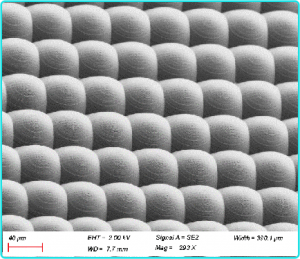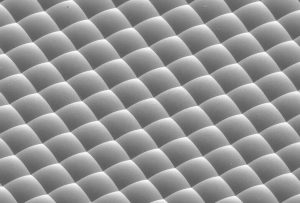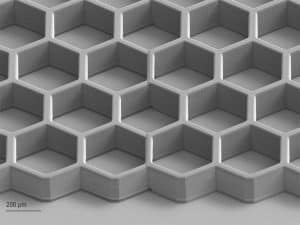
Micro and Nano Processing | Microfluidic Chips
Microfluidic microarrays have become a powerful tool for studying biological systems at single-cell resolution. Meanwhile, microfluidic chips can be widely used not only for manipulating the generation of microdroplets, microfluidic diffusion sieving and detection of protein-ligand interactions, but also for realizing molecular assays in biochemistry. Microfluidic chip technology, also known as Lab on a Chip (LOC), can integrate some important basic functions of various laboratories in chemistry, biology and physics into a very small scale chip to carry out relevant experiments.
The micro-nano-fluidic chip has many advantages, such asHigh degree of automation, high efficiency, high throughput, miniaturization, low cost and ultra-low reagent consumptionIn particular, the precision of fluid manipulation can reach nanoliter (nL) and even femtoliter (fL) accuracy in the precise manipulation of micro and nano fluids, and therefore has great research potential in many interdisciplinary fields such as biology, medicine, physics, and chemistry. In 1995, the U.S. Department of Defense proposed a handheld individual biochemical self-testing equipment project for soldiers, which triggered the international community's great interest in microfluidic chips. In 1995, the U.S. Department of Defense proposed a handheld soldier's individual biochemical self-testing equipment project, which triggered the international community to pay great attention to microfluidic chips. After that, more and more experts and scholars believed that microfluidic chips could be developed into an excellent platform for analytical chemistry, and named them "Miniaturized Total Analysis Systems" (μTAS). In 2000, Mcdonald et al. proposed a soft lithography method based on PDMS (polydimethylsiloxane) as a process substrate, which greatly simplified the processing of microfluidic chips and greatly contributed to the rapid development of microfluidic chip processing. In the same year, Quake et al. published a paper entitled "Microfluidic Large-Scale Integration" in Science, which integrated thousands of control valves and hundreds of reactors on a single chip and used microvalve and micropump technology to precisely control microfluidic flow. In 2006, Daw et al. published a report entitled "Lab on a Chip" in the journal Nature, which analyzed and explained the development and application of micro and nano flow control chips from various perspectives, and listed LOC as one of the "seven major breakthroughs of this century". was listed as one of the "seven technologies of this century". By now, the strategic significance of Lab on a Chip has been recognized by academia and industry at a higher level and in a wider scope.
When the channel size on a micro-nano-fluidic chip is reduced from the micron (µm) to the nanometer (nm) scale, the van der Waals force, electrostatic force, and capillary force inside the channel gradually dominate in the action on the fluid. The combined effect of these forces generates physical phenomena that are different from macroscale and micron fluids, such as interface-related heat transfer and greatly increased surface forces, which have stimulated great interest in nanofluidic chips.
Processing methods for micro and nano structures.
①Mainly Ultra-Violet (UV) lithography ②Electron Beam Lithograph (EBL)③Proton Beam Writing (PBW)④ Femtosecond laser two-photon direct writing technology, etc., which have been widely used in the processing technology of micro and nano flow control chips.
①UV lithography.UV light sources are widely used in high-precision processing because of their short wavelength, high photon energy, and high processing resolution. In the process of UV lithography, the material absorbs a UV photon and jumps from the ground state to the excited state to trigger the subsequent photopolymerization or photolysis reaction. The main features of UV lithography are as follows.
Small heat-affected area: the processing principle of UV lithography is a photochemical reaction principle, which destroys the chemical bonds in the processed material by direct irradiation with high-energy UV photons, thus its heat-affected area is very small or even no heat-affected area.
Processing a wide range of materials: UV source photon energy is high, so it can process some visible and infrared laser can not process materials.
High resolution: The wavelength of UV light source can generally reach 395 nm, so the diffraction limit size is smaller than that of visible light band, and therefore the resolution is high. It can be processed with a precision of 200 nm or less, enabling the acquisition of precise micro and nano structures.
The UV lithography approach can be divided intoUV mask processingandUV direct writing processingThe UV mask process requires a photoresist mask and the UV laser source is a surface light source. UV mask processing requires a photoresist mask and the UV laser source is a surface light source, while UV direct writing processing does not require a photoresist mask.
②Electron beam and ③Proton beam direct writing techniques. E-beam direct writing is a processing technique to obtain structures by direct exposure of a high-energy electron beam on a substrate coated with a photoresist (photoresist). 100 nm nanostructures were reported as early as 1965 using E-beam direct writing. The wavelength of the electron beam is very short, 0.12 nm at an accelerating voltage system of 100 KV, and according to the Abbe diffraction limit theory, the accuracy of direct electron beam writing can reach the order of nanometers.
Electron beam direct writing nanostructures offer many advantages over other conventional nanostructure processing techniques, such as.High resolution, maskless, long depth of focus, and the ability to write arbitrary nanostructures directly through computer control.The main disadvantage of electron beam direct writing is the mutual proximity effect caused by scattering in the substrate and photoresist gel layers that can cause uneven absorbed dose in the exposed region. Plasmon beam direct writing is a nanofabrication technique that directly processes nanostructures by focusing a high-energy plasmon beam into the photoresist. The penetration ability of the plasmon beam is stronger than that of the electron beam, and the spatial dispersion angle of the plasmon beam is also extremely small, so the plasmon beam direct writing can produce nanostructures with high aspect ratio.
④ Femtosecond laser two-photon direct writing technology.It is a laser light source based processing method with narrower pulse width and higher peak power than other traditional continuous laser processing technologies, often interacting with the material through nonlinear effects, processing accuracy can reach less than a hundred nanometers, and has good 3D processing capabilities, so it has great advantages in the field of micro and nano manufacturing. The femtosecond laser reaches the inside of the sample material by means of objective convergence, and since the material interacts with the femtosecond laser in a two-photon or multi-photon absorption manner, only the central region of the laser focus interacts with the material, thus breaking the optical diffraction limit and achieving high precision (resolution <100 nm) processing.
We offer fastMEMS device / micro and nanostructure processing design services, Feel free to leave a message to inquire.
Related Products
Related Reading
Micro and Nano Processing | Preparation of Micro and Nano Optical Components
Micro and Nano Processing | Preparation of Micro and Nano Optical Components Micro and Nano optical components are surface
Micro and Nano Processing | For Cellular Arraying
Micro and Nano Processing | for Cellular Arraying Cellular Microarraying (or
LIGA Plating | Machining metal microstructures, inertial sensing/RF/heat sink parts
LIGA/UV-LIGA Plating | Metal Microstructure RF


